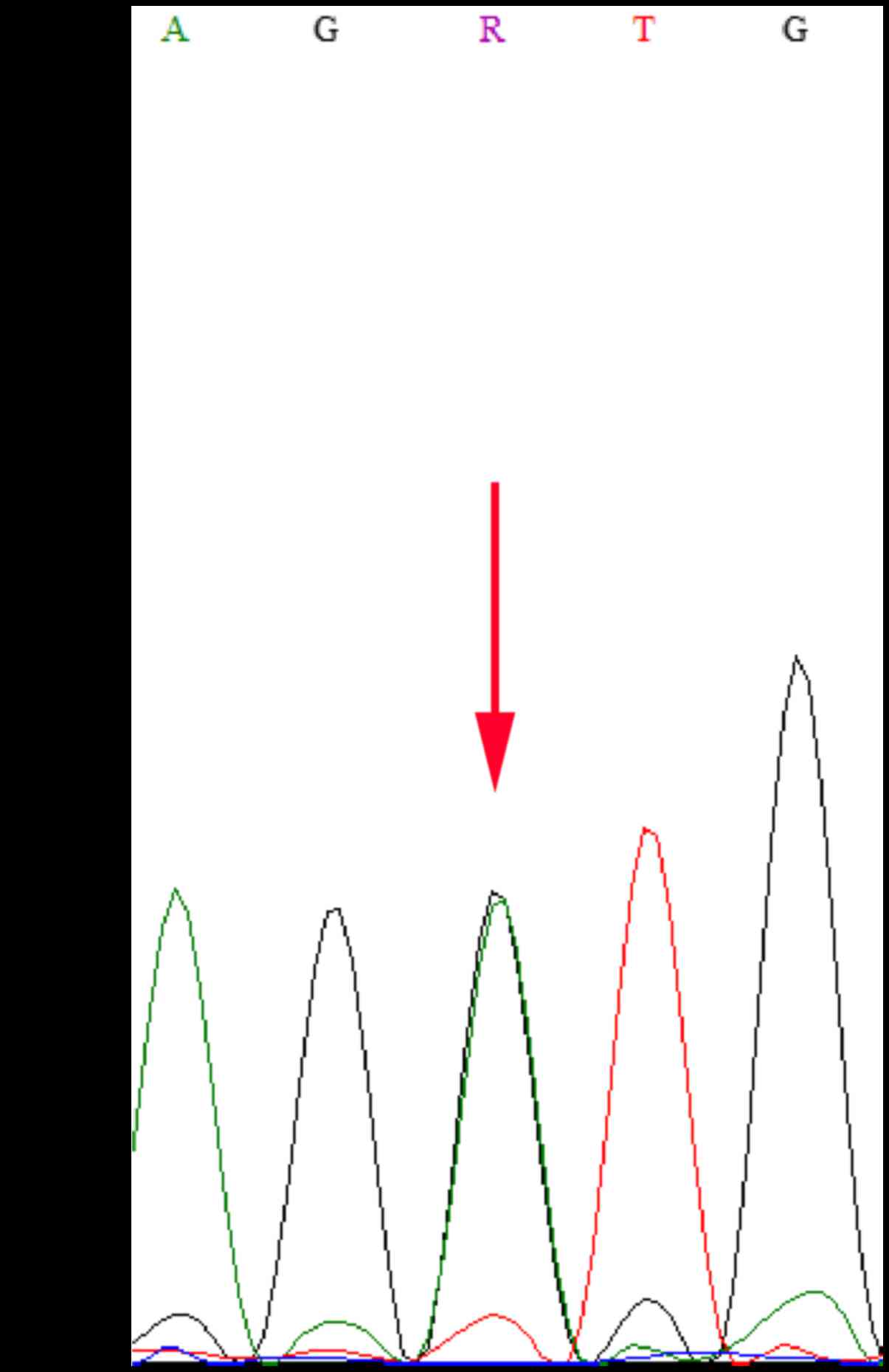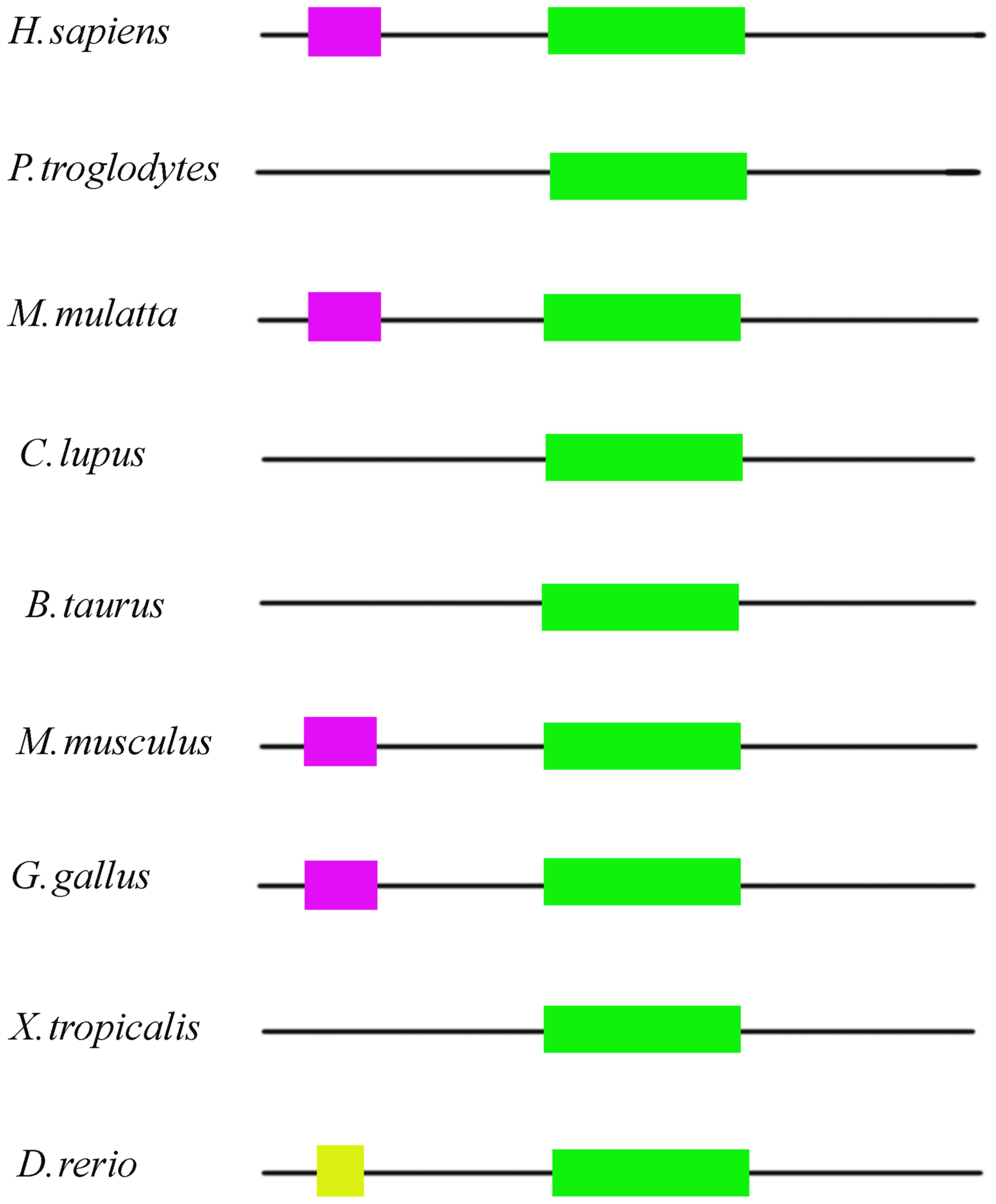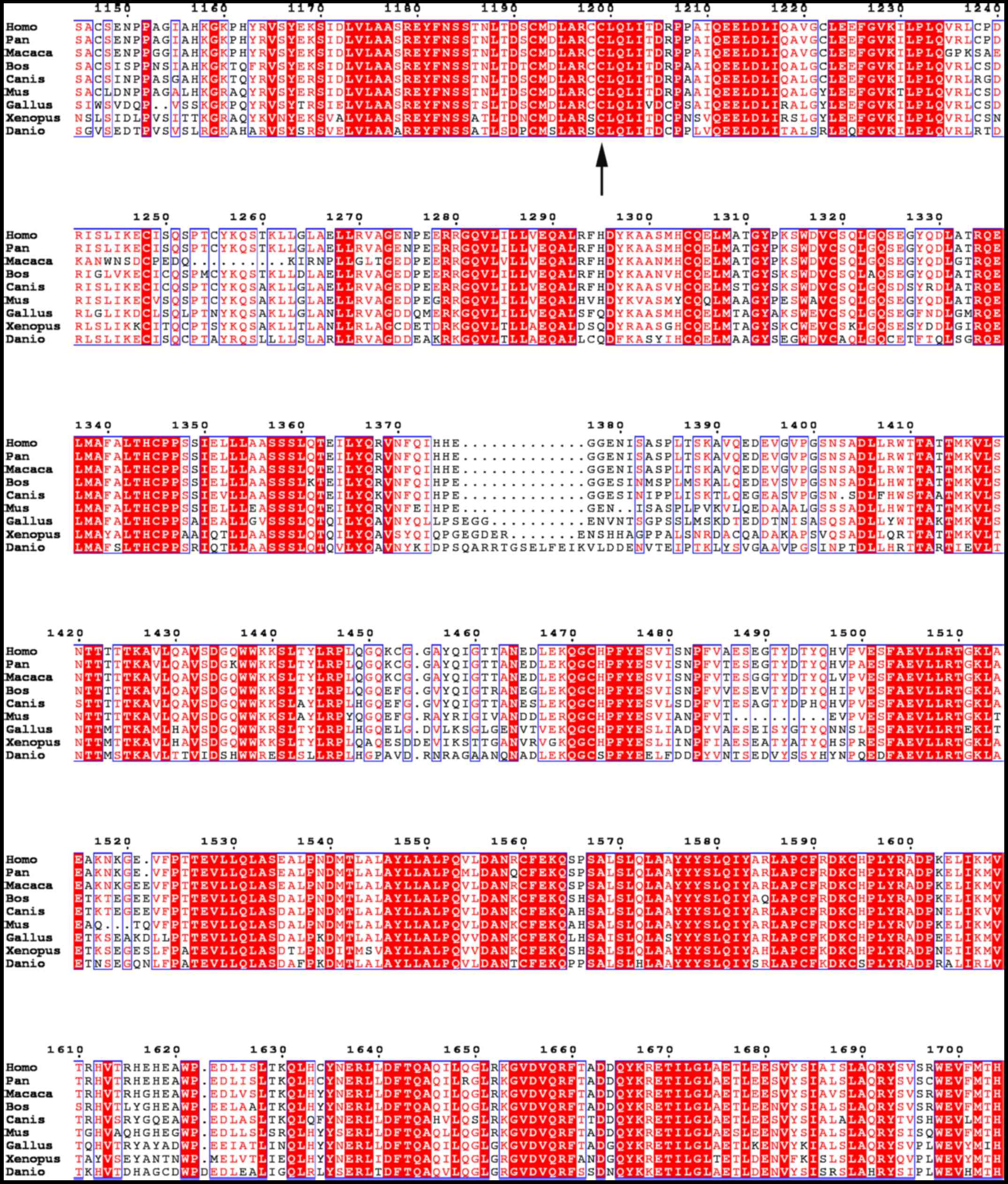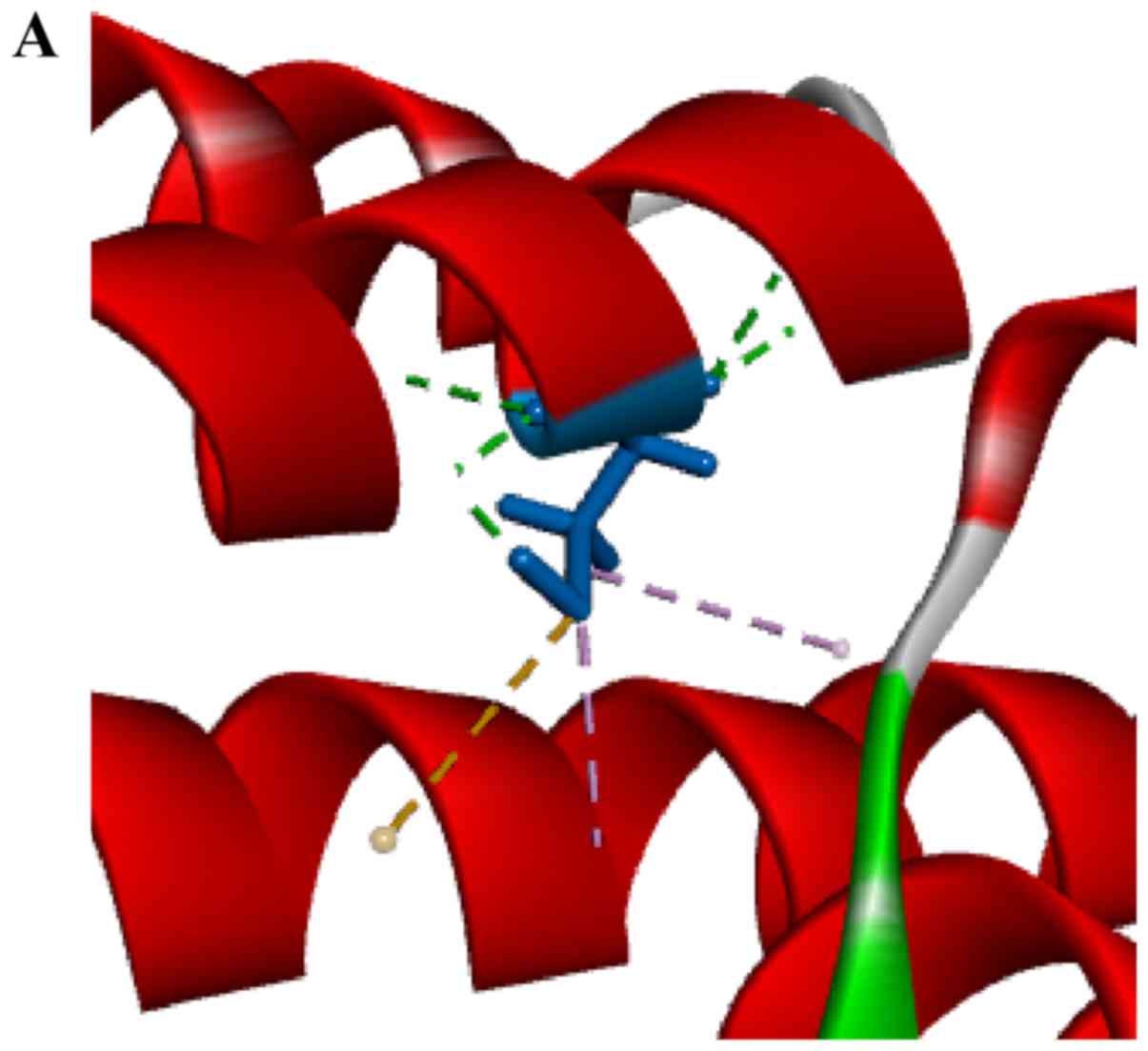Targeted next‑generation sequencing reveals two novel mutations of NBAS in a patient with infantile liver failure syndrome‑2
- Authors:
- Published online on: November 29, 2017 https://doi.org/10.3892/mmr.2017.8191
- Pages: 2245-2250
-
Copyright: © Wang et al. This is an open access article distributed under the terms of Creative Commons Attribution License.
Abstract
Introduction
Liver failure is a serious and common clinical syndrome induced in a number of different ways. With liver failure there is severe dysfunction or decompensation in liver synthesis, detoxification, excretion, and conversion. These are accompanied by coagulation disorders, jaundice, hepatic encephalopathy, ascites, and other clinical manifestations, that result in an extremely high mortality (1). Acute and subacute forms of liver failure (ALF/SLF) are the most critical.
Infantile liver failure syndrome-2 (ILFS2, OMIM 616483) is an autosomal recessive genetic disorder connected with recurrent episodes of acute liver failure during intercurrent febrile illness. Initial episodes occur in infancy or early childhood, and with conservative treatment, full recovery is achieved between episodes. Haack et al identified homozygous or compound heterozygous mutations in the neuroblastoma amplified sequence (NBAS) gene in five unrelated German patients with ILFS2 (2). NBAS was previously associated with short stature, optic nerve atrophy, and Pelger-Huet anomaly (SOPH syndrome, MIM614800) in an isolated Russian Yakut population, but without liver failure (3). Further studies have found that the phenotypic spectrum of NBAS based diseases also involve brain, connective tissue, and the immune system (4,5). The NBAS protein is involved in Golgi-to-endoplasmic reticulum (ER) retrograde transport (6) and is considered to be a component of the SNAREs (Soluble N-Ethylmaleimide-sensitive Factor (NSF) Attachment Protein Receptors). Essentially every step of membrane transport is carried out by a pair of different SNARE proteins (v-SNARE and t-SNARE). The SNARE proteins mediate intracellular transport of vesicles, such as ER to Golgi and Golgi to plasma membranes, and are conserved from yeast to human. The NBAS protein interacts with t-SNARE p31 directly and with other proteins, forming complex syntaxin 18 (7). In the cells of patients, a reduction in NBAS is accompanied by a decrease in p31, supporting an important function for NBAS in the SNARE complex (2). Although these intracellular events are known, the specific mechanisms by which NBAS contributes to liver disease and to fever, is not fully understood.
In this study, we performed targeted next-generation sequencing (NGS) to identify mutations in 358 genes related to diseases of growth and development. The purpose of this was to devise a strategy useful for genetic diagnosis of patients with abnormal growth and development. By use of this strategy, two novel mutations in NBAS were identified in a 4-year-old Chinese girl with ILFS2.
Materials and methods
Study participants
The research protocol was approved by the ethics committee of the Hubei Provincial Hospital of Traditional Chinese Medicine (Wuhan, China). The participant provided informed consent for clinical and genetic studies. Patient associated with recurrent respiratory infections, elevated transaminase, and severe hypoglycemia within the last 2 years. Based on the Online Mendelian Inheritance in Man website (OMIM), we chose specific genes linked to teratogenic and fatal diseases that would most certainly be involved in tests associated with family planning (available upon request).
Enrichment and sequencing of disease genes
Genomic DNA was extracted from blood samples using the QIAamp DNA Blood Midi kit (Qiagen, Hilden, Germany) following the manufacturer's standard procedure. The qualified genomic DNA sample was randomly fragmented by Covaris (Covaris S2; Covaris, Inc., Woburn, MA, USA) with the size of the library fragments primarily distributed between 200 and 250 bp. Illumina HiSeq SBS barcoded sequencing libraries were made based on the manufacturer's protocols (Illumina, Inc., San Diego, CA, USA). We performed 4 cycles of polymerase chain reaction (PCR). The PCR products were pooled and hybridized to the capture array for 72 h. The washing, elution, and additional amplification steps were performed according to NimbleGen protocols (F. Hoffmann-La Roche Ltd., Pleasanton, CA, USA) followed by 12 cycles of capturedligation-mediated PCR (LM-PCR). An Agilent 2100 Bioanalyzer (Agilent Technologies, Waldbronn, Germany) and ABI stepOne (Applied Biosystems; Thermo Fisher Scientific, Inc., Waltham, MA, USA) were used to estimate the magnitude of enrichment and library insert size for the final products. The libraries were sequenced byHiSeq2000 (8).
NGS data analysis
After base calling by Illumina Pipeline, the primary data were obtained by fastq. Clean data for further analysis were obtained by filtering adapter and low quality reads (9). To identify single nucleotide variants (SNVs) and indels, we aligned the 100 bp clean reads against the National Center for Biotechnology Information (NCBI) reference human genome sequence using Burrows-Wheeler Aligner software (10). Indels and SNVs were identified using the GATK (Genome Analysis Toolkit) (11). All SNVs were annotated using the dbSNP (http://www.ncbi.nlm.nih.gov/SNP/), HapMap (http://hapmap.ncbi.nlm.nih.gov/), HGMD (http://www.hgmd.org/), and the 1000 Genome (http://www.1000genomes.org/), respectively.
Sanger sequencing
Polymerase chain reaction (PCR) amplification was executed using primers specific for mutations of NBAS, which NBAS-c.209 forward, 5′-GGAAATACTTGAAACTTTTGAATAACAC-3′, and reverse, 5′-ACCTAAATGTTTGAAATGTCTCATACTG-3′; NBAS-c.3596 forward, 5′-TTATGTACTGTGGATGTAACTGTGGG-3′, and reverse, 5′-TGTTGGCTTTATTTTTTCTTTTGG-3′. PCR conditions were: i) 98°C for 30 sec; ii) 98°C for 10 sec, 55°C for 30 sec, 72°C for 30 sec, 25 cycles; ii) 72°C for 10 min; and iv) hold at 4°C. The amplified products were sequenced using an ABI 3730 DNA Analyzer (Applied Biosystems; Thermo Fisher Scientific, Inc.) by capillary electrophoresis and analyzed using BioEdit (http://www.mbio.ncsu.edu/BioEdit/bioedit.html). NM_015909.3 was chosen as the reference sequence.
Calculation of the stability of predicted mutations
Potential deleterious effects of identified sequence variants were assessed by various algorithms; PolyPhen-2 (http://genetics.bwh.harvard.edu/pph2/) (12), SIFT (http://sift.jcvi.org/) (13), and Mutation Taster (http://mutationtaster.org/) (14). In theory, mutations usually alter the structural stability of the protein and thus affect its functional activity. Human Splicing Finder (http://umd.be/HSF3/) was used to analyze pre-mRNA splicing (15). In order to check the energy stability of the mutants, the Web server I-Mutant 3.0 (http://gpcr2.biocomp.unibo.it/cgi/predictors/I-Mutant3.0/I-Mutant3.0.cgi) was used (16). The I-Mutant 3.0 suite is based on a support vector machine (SVM) algorithm that calculates protein stability related to a single mutation in units of free energy (ΔΔG).
Sequence conservative analysis and computer modeling
Conservation across species indicates that a sequence has been maintained by evolution despite speciation. In this study, conservation analysis showed the degree of conservation across species at each residue of a given protein. CLUSTALW (http://www.genome.jp/tools/clustalw/) was used to compare homologous protein sequences among nine representative species; Homo sapiens (human), Pan troglodytes (chimpanzee), Macaca mulatta (Rhesus monkey), Canis lupusfamiliaris (dog), Bos taurus (cattle), Mus musculus (house mouse), Gallus gallus (chicken), Xenopus tropicalis (tropical clawed frog), and Danio rerio (zebrafish). The alignment result was exported by EsPript (http://espript.ibcp.fr/ESPript/ESPript/). Homology modeling and refining were conducted by the YASARA program using default parameters (http://www.yasara.org/). The model was visualized with the Pymol Molecular Graphics system (http://pymol.org/).
Results
Clinical status
The patient was a 4-year-old female with repeated upper respiratory tract infections that were associated with fever. There were no obvious physical abnormalities upon examination. Routine blood analysis showed a slightly elevated white blood cell count and a slightly elevated level of C-reactive protein (CRP). Liver function was abnormal: Alanine transaminase (ALT) 4,790 U/l, aspartate transaminase (AST) 7,690 U/l, alkaline phosphatase: 253 U/l; total bile acid: 267.5 µmol/l, blood glucose: 7.80 mmol/l, lactate dehydrogenase: 3,230 U/l; α-hydroxybutyrate dehydrogenase: 1,541 U/l, creatine kinase (CK) isoenzyme: 30.9 U/l, and CKMB/CK: 0.36. After anti-infection and liver-protection treatment (10% glucose 100 ml, reduced glutathione 0.45 i.v., 10% glucose 200 ml, and compound glycyrrhizin glucoside 40 mg, i.v. drip), symptoms mitigated and liver function normalized. After hospital discharge, the patient had repeated upper respiratory tract infections associated with fever and was readmitted to hospital for treatment. AST and ALT were abnormal for unknown reasons, even though there was no history of hepatitis.
High-throughput sequencing, mapping, and coverage
In this study, we designed a unique high-density array to capture all exons and 200 bp adjacent intron sequences of 358 genes related to growth and development diseases. The enriched DNA was sequenced at single-base resolution using the Illumina HiSeq2000 Analyzer. Of the reads, 53.66% mapped to target regions and 52.64% mapped to flanking 200 bp regions. Coverage of target regions was 99.51% and the average sequencing depth for target regions was 108.1x. The fraction of target regions covered was at least 4x, 10x, 20× and were respectively, 99.25, 98.34, and 96.01%.
Determination clinical significance of genetic variants
All variants meeting the filtering criteria, described below, are listed in Table I. First, the allele frequency of variants should be less than 0.05 in the dbSNP, HapMap, 1,000 human genome dataset. Second, variants were considered as likely disease mutations, if sequence variation was previously reported and was a recognized cause of the disorder in dbSNP and HGMD. Third, variants were retained as disease mutations if they were predicted to result in a premature stop codon or loss of a substantial portion of the protein. Fourth, the variation was new, was forecasted to be harmful, and its allele frequency was less than 0.05. If these four criteria were met then the mutation was considered a disease mutation.
In this study, the following NBAS SNVs were detected; c.6220G>A (p.A2074T), c.3596G>A (p.C1199Y), c.209+1G>A, c.1964A>G (P.K655R), and c.727A>G (p.I243V). Among them, although SIFT and PolyPhen-2 predicted that c.6220G>A was, respectively, harmful and potentially harmful, the frequency of the SNV in the three databases was 0.1821, 0.2434, and 0.1841 and was not studied further. In other words, this SNV appears to be common. In addition, c.1964A>G in the three databases was respectively, 0.497, 0.343, and 0.3397. The frequency of c.727A>G in the three databases was respectively, 0.4999, 0.333, and 0.3535. From this frequency information these two SNVs were also common in the population. Two uncommon SNVs were c.3596G>A and c.209 + 1G>A, which had no demonstrable allele frequency in the three databases. For c.3596G>A, SIFT's prediction was harmful and the I-Mutant 3.0 ΔΔG value was predicted to be −0.22 kcal/mol and SVM3 predicted a Large Decrease (Table II). This information identified these two sites as potentially pathogenic.
Mutations analysis
Mutations c.3596G>A and c.209+1G>A were further confirmed by directional Sanger sequencing (Fig. 1). We analyzed the mutation, c.209+1G>A, using the Human Splicing Finder program (http://umd.be/HSF3/index.html). Mutations found in this way alter the wild-type donor site, most likely affecting splicing. This heterozygous mutation was located at the splice donor site of intron 3, forming a new cleavage donor site that would result in the formation of frame shift mutations in the protein product and ultimately premature coding (Table II). Such a truncated protein product would lose its normal function, resulting in disease (17). The amino acid conservativeness of the c.3596G>A mutation was analyzed. NBAS was found to be conserved in human, chimpanzee, Rhesus monkey, dog, cattle, house mouse, chicken, tropical clawed frog, and zebrafish (Fig. 2). The SEC39 region of the protein was found to be highly conserved. The SEC39 region is a necessary part of Golgi-ER retrograde transport, and the mutation was located in this evolutionary conserved region (Fig. 3).
Computer modeling
In order to understand the effect of the c.3596G>A mutation on protein structure, a homology simulation for the SEC39 region was performed. The homology simulation was based on protein transport protein SEC39 (3k8p). Modeling and optimization was performed using YASARA software. Based on the protein model obtained by homology modeling, both cysteine and tyrosine were uncharged polar R-based amino acids, and on the whole, the model did not change (Fig. 4A). The wild-type model appears more reasonable (Fig. 4B) in that the mutation model has a large amount of unreasonable steric hindrance. This conclusion implies that this mutation may lead to structural changes throughout the SEC39 region or the entire protein.
Discussion
Human genetic diseases typically occur in about 8% of the population (18). Over the past decade, advances in technology have enabled the detection of all sequence changes in a single genome in a cost-effective manner. High throughput sequencing combined with capture techniques are increasingly used for routine diagnosis of Mendelian disease. Infantile liver failure is a rare but life-threatening disease. Mutations in NBAS are known causes of acute liver failure in children with fever. However, the physiological role of NBAS is not particularly clear.
In this study, we have identified two deleterious and rare variants by target NGS sequencing of 358 growth and development associated genes in a 4-year-old girl with ILFS2. Based on the child's medical history, clinical manifestations, laboratory examination, the young age of the patient, and an unknown etiology, hereditary liver disease was considered. However, the results here in show that by second-generation and Sanger sequencing NBAS mutations are the likely cause of the child's medical condition and that a diagnosis of ILFS2 is appropriate. One missense mutation c.3596G>A (p.C1199Y) and one splice site mutation c.209 + 1G>A were detected in the coding region of NBAS (NM_015909.3), both of which were heterozygotic. Missense mutations can lead to amino acid changes and may affect protein function while splice site mutations can cause intronic shear errors, which impact mRNA expression. The NBAS protein interacts with ZW10 and RINT1 at amino acid position 1,036 to 2,371, which supports the classification of the missense variant c.3596G>A as pathogenic (7,19).
This finding increases the number of NBAS mutations associated with the disease and will facilitate further studies of the syndrome. These results provide further insight into the molecular pathogenesis of the disease and identifies relationships among gene mutations and clinical manifestations of this syndrome.
References
|
Lee WM: Recent developments in acute liver failure. Best Pract Res Clin Gastroenterol. 26:3–16. 2012. View Article : Google Scholar : PubMed/NCBI | |
|
Haack TB, Staufner C, Kopke MG, Straub BK, Kölker S, Thiel C, Freisinger P, Baric I, McKiernan PJ, Dikow N, et al: Biallelic mutations in NBAS cause recurrent acute liver failure with onset in infancy. Am J Hum Genet. 97:163–169. 2015. View Article : Google Scholar : PubMed/NCBI | |
|
Maksimova N, Hara K, Nikolaeva I, Chun-Feng T, Usui T, Takagi M, Nishihira Y, Miyashita A, Fujiwara H, Oyama T, et al: Neuroblastoma amplified sequence gene is associated with a novel short stature syndrome characterised by optic nerve atrophy and Pelger-Huet anomaly. J Med Genet. 47:538–548. 2010. View Article : Google Scholar : PubMed/NCBI | |
|
Segarra NG, Ballhausen D, Crawford H, Perreau M, Campos-Xavier B, van Spaendonck-Zwarts K, Vermeer C, Russo M, Zambelli PY, Stevenson B, et al: NBAS mutations cause a multisystem disorder involving bone, connective tissue, liver, immune system, and retina. Am J Med Genet A. 167A:1–2912. 2015.PubMed/NCBI | |
|
Capo-Chichi JM, Mehawej C, Delague V, Caillaud C, Khneisser I, Hamdan FF, Michaud JL, Kibar Z and Mégarbané A: Neuroblastoma amplified sequence (NBAS) mutation in recurrent acute liver failure: Confirmatory report in a sibship with very early onset, osteoporosis and developmental delay. Eur J Med Genet. 58:637–641. 2015. View Article : Google Scholar : PubMed/NCBI | |
|
Staufner C, Haack TB, Köpke MG, Straub BK, Kölker S, Thiel C, Freisinger P, Baric I, McKiernan PJ, Dikow N, et al: Recurrent acute liver failure due to NBAS deficiency: Phenotypic spectrum, disease mechanisms and therapeutic concepts. J Inherit Metab Dis. 39:3–16. 2016. View Article : Google Scholar : PubMed/NCBI | |
|
Aoki T, Ichimura S, Itoh A, Kuramoto M, Shinkawa T, Isobe T and Tagaya M: Identification of the neuroblastoma-amplified gene product as a component of the syntaxin 18 complex implicated in Golgi-to-endoplasmic reticulum retrograde transport. Mol Biol Cell. 20:2639–2649. 2009. View Article : Google Scholar : PubMed/NCBI | |
|
Yang Y, Mao B, Wang L, Mao L, Zhou A, Cao J, Hu J, Zhou Y, Pan Y, Wei X, et al: Targeted next generation sequencing reveals a novel intragenic deletion of the LAMA2 gene in a patient with congenital muscular dystrophy. Mol Med Rep. 11:3687–3693. 2015. View Article : Google Scholar : PubMed/NCBI | |
|
Wei X, Ju X, Yi X, Zhu Q, Qu N, Liu T, Chen Y, Jiang H, Yang G, Zhen R, et al: Identification of sequence variants in genetic disease-causing genes using targeted next-generation sequencing. PloS One. 6:e295002011. View Article : Google Scholar : PubMed/NCBI | |
|
Li H and Durbin R: Fast and accurate short read alignment with Burrows-Wheeler transform. Bioinformatics. 25:1754–1760. 2009. View Article : Google Scholar : PubMed/NCBI | |
|
van der Auwera GA, Carneiro MO, Hartl C, Poplin R, Del Angel G, Levy-Moonshine A, Jordan T, Shakir K, Roazen D, Thibault J, et al: From FastQ data to high confidence variant calls: The genome analysis toolkit best practices pipeline. Curr Protoc Bioinformatics. 43:11.10.1–33. 2013. | |
|
Adzhubei IA, Schmidt S, Peshkin L, Ramensky VE, Gerasimova A, Bork P, Kondrashov AS and Sunyaev SR: A method and server for predicting damaging missense mutations. Nat Methods. 7:248–249. 2010. View Article : Google Scholar : PubMed/NCBI | |
|
Kumar P, Henikoff S and Ng PC: Predicting the effects of coding non-synonymous variants on protein function using the SIFT algorithm. Nat protoc. 4:1073–1081. 2009. View Article : Google Scholar : PubMed/NCBI | |
|
Schwarz JM, Cooper DN, Schuelke M and Seelow D: MutationTaster2: Mutation prediction for the deep-sequencing age. Nat Methods. 11:361–362. 2014. View Article : Google Scholar : PubMed/NCBI | |
|
Desmet FO, Hamroun D, Lalande M, Collod-Beroud G, Claustres M and Beroud C: Human splicing finder: An online bioinformatics tool to predict splicing signals. Nucleic Acids Res. 37:e672009. View Article : Google Scholar : PubMed/NCBI | |
|
Capriotti E, Fariselli P, Rossi I and Casadio R: A three-state prediction of single point mutations on protein stability changes. BMC Bioinformatics. 9 Suppl 2:S62008. View Article : Google Scholar : PubMed/NCBI | |
|
Richards S, Aziz N, Bale S, Bick D, Das S, Gastier-Foster J, Grody WW, Hegde M, Lyon E, Spector E, et al: Standards and guidelines for the interpretation of sequence variants: A joint consensus recommendation of the american college of medical genetics and genomics and the association for molecular pathology. Genet Med. 17:405–424. 2015. View Article : Google Scholar : PubMed/NCBI | |
|
Baird PA, Anderson TW, Newcombe HB and Lowry RB: Genetic disorders in children and young adults: A population study. Am J Hum Genet. 42:677–693. 1988.PubMed/NCBI | |
|
Civril F, Wehenkel A, Giorgi FM, Santaguida S, Di Fonzo A, Grigorean G, Ciccarelli FD and Musacchio A: Structural analysis of the RZZ complex reveals common ancestry with multisubunit vesicle tethering machinery. Structure. 18:616–626. 2010. View Article : Google Scholar : PubMed/NCBI |













